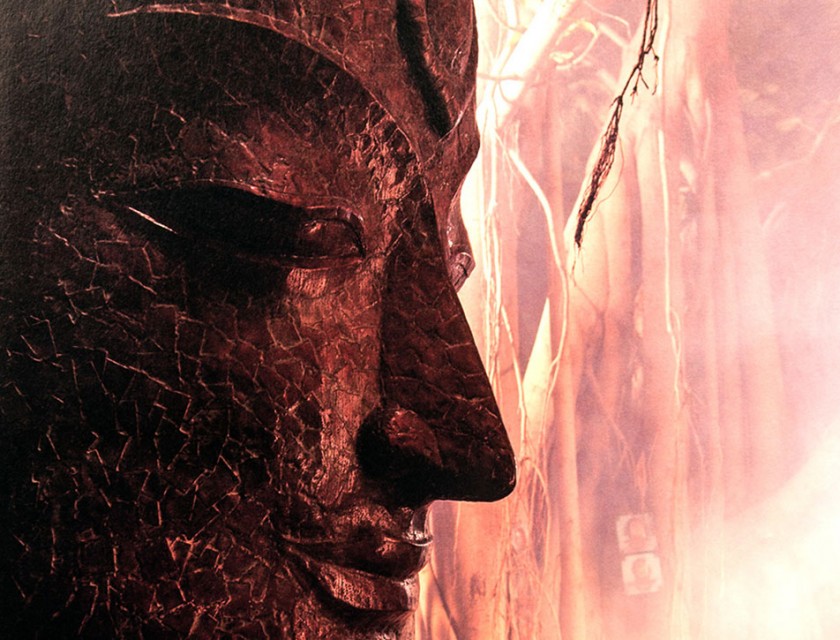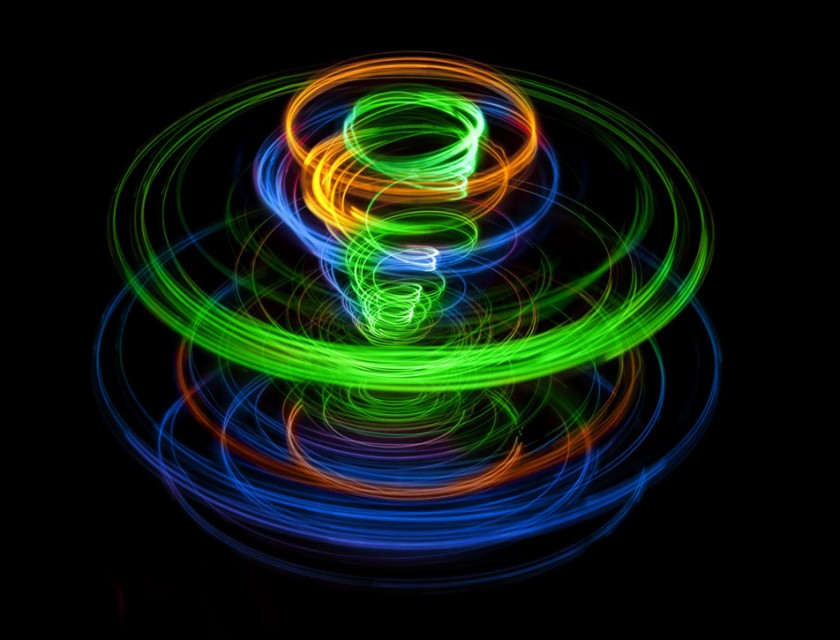Matrika Shakti as explained in the Shaktopaya of the Shiva Sūtras
The Shiv sūtras were first revealed in the late 8th century A.D. by Shiva to Vasugupta in person on mount Mahadeva in the Kashmir Himalayas. Later expounded by one of his students Abhinavagupta, this philosophy came to be known as Kashmir Shaivism and is an integral part of the Agamas literature in Hindu thought.
The Spanda-kaarikas are a commentary on the Shiva- sūtras whose authorship is credited to Kallatta, a chief disciple. The first Shlöka of these kaarikas underlines the very act of Creation & Destruction of this ephemeral Universe as the mere blink of Shiva’s eyes:-  We laud that Shankara, by whose mere opening and shutting of the eye-lids, there is the appearance and dissolution of the world and who is the source of the glorious powers of the collective whole of the shaktis in various forms.
We laud that Shankara, by whose mere opening and shutting of the eye-lids, there is the appearance and dissolution of the world and who is the source of the glorious powers of the collective whole of the shaktis in various forms.
(1st Shloka) Spanda-kaarikaas, ‘The Divine Creative Pulsation’ by Jaidev Singh[1]
Spanda literally means a ‘throb’, a pulsation of energy that spawns all creation. One blink of Shiva’s eyes, the unmesha and the nimesha, releases an intense cosmic pulse that unfolds billions of years of galactic causation. The Unknown in the Shiva- sūtras is the Naad-Brahman and this initial pulse is termed as the Naad-bindu. This is the ‘Big bang’ of Hindu thought and it is from this bindu that the latent Shaktis arise in all their multitudinous, infinite forms onto this mayanvic stage of the senses.
The Shiv sūtras have three Sections viz. Shāmbhavopāya, Shāktopāya and Ānavopāya. The word upāya means a spiritual discipline and is synonymous with Yoga. In the first section Shāmbhavopāya, the goal of the seeker is the Prakash or the eternal light of Shiva. This comes from spontaneous realization and the path actually progresses from Ānavopāya to Shāktopāya and then to Shāmbhavyoga. In this latter stage the plain simple ‘desire’ or iccha of the follower is sufficient to bring about realization. In the words of Jaidev Singh -“When we neither accept, nor reject, when there is simple awareness freed of all idealization, then there is sudden, spontaneous flash of experience of our essential Self : This is Shāmbhava Samāvesha – an instantaneous flash of Understanding.”
The Ānavopāya has as its first sutra – “cittam ātmā “… while the first sutra of the Shākta upāya is “cittam mantrah.” It is interesting to compare the two for the difference that underlines their functioning. The word ‘cittam‘ means the entire complex of the mind including the intellect – buddhi, ego – ahamkāra, sub-conscious – antahkarna ; it is the ‘seat of consciousness’. Ātmā is the Self therefore in the Ānavopāya the path to Shiva is through external effort or krīyā. All worldly desires are assimilated into ‘one object or deity’ and all action, that is mostly ritualistic, is focused towards this singular goal. The Self is treated in psychological isolation from the Whole i.e. is it is Anu or ‘individually encapsulated’. And hence the name of this Section is Ānavopāya but is also known in other contexts as krīyā-yoga.
The Shāktopāya, on the other hand, adopts the path of jñāna or pure knowledge. The medium of inquiry is the ‘consciousness’ or Vimarsha and here one has to make use of the ‘citta-shaktī ‘ or mental energy. The mind is the laboratory and the structure of the ‘mantra‘ is the process and thus the first sutra – “cittam mantrah“. The adoption of the appropriate mantra is the essence of this practice. The Shāktopāya says that it is not possible for most people to be free of desires or vikalpa in the normal course. They are subjected to the temptation of a variety of ‘wrong desires’ or ashuddha-vikalpa. Then what is the way forward?
Citing Abhinavagupta, Jaidev Singh explains[2] – “Catch hold of one shuddha- vikalpa. That will prove to be a veritable boat by which we can cross the turbulent waters of phenomenal existence and safely land on the certain ground of our noumenal Reality. In the following passages, Abhinavagupta clearly explains the nature of ashuddha and shuddha-vikalpa. regarding ashuddha-vikalpa, he says : ‘People consider themselves bound on account of ashuddha-vikalpa. This wrong conception of theirs about themselves becomes the cause of their being bound in trans-migratory existence. Therefore when an opposite vikalpa arises, it dispels the vikalpa that is the (earlier) cause of trans-migratory existence and thus becomes the cause of their (the people’s) elevation.’
‘People consider themselves bound on account of ashuddha-vikalpa. This wrong conception of theirs about themselves becomes the cause of their being bound in trans-migratory existence. Therefore when an opposite vikalpa arises, it dispels the vikalpa that is the (earlier) cause of trans-migratory existence and thus becomes the cause of their (the people’s) elevation.’
Ashuddha-vikalpa or ‘misconceptions’ are those ideas and beliefs on account of which one considers his psycho-physical organism, his mind-body complex to be the Self. ‘I am thin, weak, ignorant etc.’ are examples of ashuddha-vikalpas. “
“What then is shuddha-vikalpa (correct mental attitude and belief)? This is what Abhinavagupta has to say : ‘That which is unlimited consciousness transcending all limited expressions of Reality from the earth right up to Shiva, that alone is the highest Reality; that am I. Therefore I am both transcendent to and immanent in the Universe.’
‘That which is unlimited consciousness transcending all limited expressions of Reality from the earth right up to Shiva, that alone is the highest Reality; that am I. Therefore I am both transcendent to and immanent in the Universe.’
The shuddha-vikalpa is the idea and belief that I am the met-empirical, transcendental Self; that the Universe is an expression of my power, etc. that is (the Shakti of consciousness or Vimarsha).”
■■ “The practice of this shuddha-vikalpa is the Shāktopāya. A question that arises here is – Can the highest Reality or parama Shiva be ever brought within the range of vikalpa ?…. because that would mean that the highest Reality can be brought within the province of thought. And, if not, then what is the utility of this shuddha-vikalpa ? “
In this paper, we will attempt to answer this question….
Let us first understand how the concepts of Shiva- sūtras resonate with the vast body of Vedic literature. The word sūtra literally means ‘a thread’ and interestingly, we see that the following sūtra II.7, helps us in unraveling the essence of Shāktopāya. It states[3] :- “( From a pleased Guru ) accrues enlightenment regarding the ‘group of letters’.”
“( From a pleased Guru ) accrues enlightenment regarding the ‘group of letters’.”
Now the first sūtra – “cittam mantrah“, as discussed above, clearly indicates the way to subdue the ‘chatter’ of everyday life in our citta or consciousness, is to commence with a mantraḥ as a shuddha-vikalpa. Make this the summum-bonum or the ‘highest goal’ of one’s life and then neutralize it to empty one’s mind along with all its worldly desires, to achieve a state of tabula-rasa – a mind like an empty slate.
The mantrās, however, are constructed of words and letters and these letters are the mātrikā shaktīs. As we will now see this mātrikā or the ‘string’ of Sanskrit alphabet reflects within itself the symmetry of the Universe and its creative principle. The mātrika-chakra literally meaning the ‘Mother-wheel’. These are arranged in a circle or chakra much like the beads in a rosary and each letter has its individual universal resonant energy, a Divine Shakti .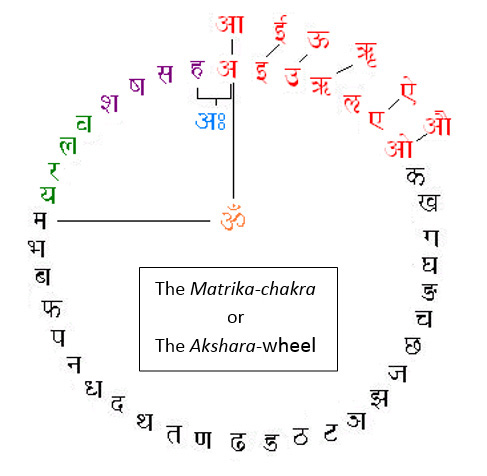 A single letter of the alphabet in Sanskrit is called akshara. In the Upanishads Brahman, the Unknown, is also called akshara.[4] For, akshara has neither any substance nor does it possess any attributes. It is indestructible and undifferentiated. That which is dissoluble and melts away is called kshara and the opposite is a-kshara where the prefix ‘a’ denotes the negative. In other words akshara is to be first understood as the Imperishable, the constant in the universe, it is the Brahman and is the very pivot of this creation.
A single letter of the alphabet in Sanskrit is called akshara. In the Upanishads Brahman, the Unknown, is also called akshara.[4] For, akshara has neither any substance nor does it possess any attributes. It is indestructible and undifferentiated. That which is dissoluble and melts away is called kshara and the opposite is a-kshara where the prefix ‘a’ denotes the negative. In other words akshara is to be first understood as the Imperishable, the constant in the universe, it is the Brahman and is the very pivot of this creation.
The word aksha also means the axle or the beam on which the cart’s wheel is balanced so akshara is T.S. Elliot’s ‘still point’, ‘the fixity’[5] about which all things rotate but itself remains unmoved. This unbounded sphere ‘whose centre is everywhere and the circumference nowhere’ finds an egocentric limitation, an adjunct within the individual self. This human body is endowed with the organs of speech and here the meaning of akshara becomes the syllable – a small utterance. And this is ‘a’ ( A ) – the first letter of the Sanskrit alphabet.
● Lord Krishna explains to Arjuna in the Gita 10.33 :-
I am the first letter ‘a’ among the akshara of the alphabet and am integral in the compounding of words in grammar. I am indestructible time. I am the Dispenser facing everywhere.
The Sanskrit alphabet, unlike English, has the collection of vowels as a primary list called svars . The consonants are a secondary list and are called vyanjan . The svars are the ‘shining’ sounds and the vyanjan are the ‘reflected’ sounds. In the diagram above, the letters in red are the svars , the vowels. These are 13 in number and if ‘a’ ( A ), that stands for Brahman , the Unknown is suppressed we are left with 12 – the number of sun-signs. The vowels are like the day and they are the ‘shining ones’. They contribute the mātrā or the meter and timing to the words and the mantras.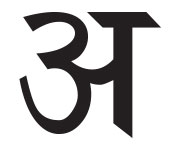 The aksharas in black are the sparsh, the mute-consonants. These are the ‘dark ones’ and are 25 in number. Each letter e.g. the first ‘k’ needs the ‘a’ sound to complete it, for it is pronounced as ‘ka’. Therefore the mute-consonants have 26 syllables and this approximately is the number of waxing & waning cycles of the moon in a year.
The aksharas in black are the sparsh, the mute-consonants. These are the ‘dark ones’ and are 25 in number. Each letter e.g. the first ‘k’ needs the ‘a’ sound to complete it, for it is pronounced as ‘ka’. Therefore the mute-consonants have 26 syllables and this approximately is the number of waxing & waning cycles of the moon in a year.
The Divine reveals itself in serendipitous ways. There are many more symmetries embedded within this akshara-wheel that confirm this mysterious method.
The first svar is ‘a’ and it is added to the end of every consonant. From there it integrates into every word and sentence. Thus ‘a’ ( A ) , the Brahman becomes “woven into the warp and woof of everything” in the words of Late Dr. S. Radhakrishnan. This structuring is unique to the Sanskrit language.
The Imperishable akshara seeds each letter of the alphabet and becomes manifold. These voiced syllables, structured into words and sentences, give rise to action. In the Gita an entire Section 8, titled ‘Akshara Brahma Yoga’ explains how our karma arises from thought and how thought arises from the multiplicity of the Akshara Brahma.
- In terms of rigorous logic if Brahman, the Unknown manifests, it relegates Itself ! This epistemological problem is circumvented in Indian thought by introducing the concept of Ishvara. Where Brahman is the Absolute God, Ishvara reflects its power of Self-determination….this is best explained by using S. Radhakrishnan’s words [6]….
Brahman – Ishvara , here the first term indicates Infinite being and possibility, and the second suggests creative freedom. Why should the Absolute Brahman perfect, infinite, needing nothing, desiring nothing, move out into this world ? It is not compelled to do so. It may have this potentiality but it is not bound or compelled by it. It is free to move or not to move, to throw itself into forms or remain formless. If it indulges its power of creativity, it is because of its free choice.
In Ishvara we have the two elements of wisdom and power, Shiva and Shakti. By the latter the Supreme who is unmeasured and immeasurable becomes measured and defined. Immutable being becomes infinite fecundity.
Now, we have seen that ‘a’ ( A ) is akshara and similarly its manifestation Ishvara is the lengthened second vowel ‘i’ ( [- ) . Thus it can be understood as i-svara, literally meaning the “‘i’ ( [– ) vowel”. The Vedic equivalent of Ishvara is Lord Indra . The Aitareya Upanishad I .3.14 explains why Indra is so named. Idam means ‘this’ and ‘that which can be seen’ is idam adarsham. This is shortened to idamdra and further to Indra, a cryptic version ‘because the Gods like mysterious names’. In essence Indra like Ishvara is the perceivable projection of Brahman .
The Vedic equivalent of Ishvara is Lord Indra . The Aitareya Upanishad I .3.14 explains why Indra is so named. Idam means ‘this’ and ‘that which can be seen’ is idam adarsham. This is shortened to idamdra and further to Indra, a cryptic version ‘because the Gods like mysterious names’. In essence Indra like Ishvara is the perceivable projection of Brahman .
- ‘u’ ( ] ) is the unfolding maya, it is the measure of things as our consciousness moulds out forms in the formless. The Brihadaranyaka Upanishad shlöka I.3.23 says :-
 And this ‘u’ is ‘udgītha’, the universal song. The vital breath ‘prana’ is ‘ut’, for by vital breath is this whole creation upheld, supported. The universal song, verily, is speech. This is ‘udgītha’, for it is ‘ut’ and ‘gītha’.
And this ‘u’ is ‘udgītha’, the universal song. The vital breath ‘prana’ is ‘ut’, for by vital breath is this whole creation upheld, supported. The universal song, verily, is speech. This is ‘udgītha’, for it is ‘ut’ and ‘gītha’.
The compilation of entire knowledge is the ‘universal song’, Gītā. In its full form it should be called ‘udgītha’ . ‘Ud’ means ‘to evolve’ and ‘ut’ is the ‘life breath’ or prana ; coupled with speech this vital breath gives ‘name and form’ to all things in this conscious universe.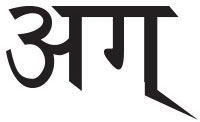 Ishvara is the eternal order. It can be sensed, yes, but yet it is strangely uniform, devoid of any dimensions of space, time and so forth. This is the samsara , the Sanskrit word for the world. Sam means ‘the same everywhere’. Sara means ‘the essence’. In this dimensionless world the only disturbance, according to the Vedic Hymns of Creation, is a thought – “Let me be” – the Creator’s need to have a Self. This ‘thought’ disturbs the Uniformity, the Order, giving rise to the Chaos & Order dichotomy. The dimensions unfold and the Creator, Preserver & Destroyer trinity takes form. This trinity is variously explained in the texts, but for our purpose here, we consider Ishvara as the creative equanimity ; Shiva as the chaotic destroyer and Vishnu as the one that preserves order. In the galaxies above us, the supernovas are bursting with tremendous energies and the black holes are coalescing these under crushing gravitational forces. These are the two extremes of the visible universe and beyond these all scientific explanations seize. The expanding supernovas is Vishnu that is always depicted with agni or fire emanating from it. The root verb ‘ag’ means ‘a tortuous movement’ and the suffix ‘ni’ means in this context ‘to throw out’. So, agni is ‘the flickering of the flame’ that shines and spews forth energy. The opposite is n-agni or nāgini that means a snake, literally ‘a black tortuous movement’ that absorbs energy.
Ishvara is the eternal order. It can be sensed, yes, but yet it is strangely uniform, devoid of any dimensions of space, time and so forth. This is the samsara , the Sanskrit word for the world. Sam means ‘the same everywhere’. Sara means ‘the essence’. In this dimensionless world the only disturbance, according to the Vedic Hymns of Creation, is a thought – “Let me be” – the Creator’s need to have a Self. This ‘thought’ disturbs the Uniformity, the Order, giving rise to the Chaos & Order dichotomy. The dimensions unfold and the Creator, Preserver & Destroyer trinity takes form. This trinity is variously explained in the texts, but for our purpose here, we consider Ishvara as the creative equanimity ; Shiva as the chaotic destroyer and Vishnu as the one that preserves order. In the galaxies above us, the supernovas are bursting with tremendous energies and the black holes are coalescing these under crushing gravitational forces. These are the two extremes of the visible universe and beyond these all scientific explanations seize. The expanding supernovas is Vishnu that is always depicted with agni or fire emanating from it. The root verb ‘ag’ means ‘a tortuous movement’ and the suffix ‘ni’ means in this context ‘to throw out’. So, agni is ‘the flickering of the flame’ that shines and spews forth energy. The opposite is n-agni or nāgini that means a snake, literally ‘a black tortuous movement’ that absorbs energy.
Thus, Shiva is portrayed with snakes around his neck. The river Ganges entangled in Shiva’s flowing mane, at another level, stands for ‘ākāsh-Gangā’ – the Sanskrit name for our galaxy ‘the Milky-way’.
Shakti, power is the flow of energy between the Vishnu and Shiva back and forth. Each letter of the mātrika-chakra has its individual resonant sound and these combine as root verbs, words, shlökas and mantras to enable the ‘naming’ and ‘explaining’ of each and every aspect of life and its concepts. The multitudinous variety of these names and their possibilities far exceeds the Cantor’s ‘numerable infinite’ and this is how the following sibilants – the “Shakti” symbols or Ūhsma are delineated…
- If we go back to the akshara-wheel , the last four letters in indigo viz. sh ( Sa ), shh ( Ya ), sa ( sa ) and ha ( h ) are the Sibilants or Ūshma. They are the “Shakti” symbols. The first three of these aksharas can be linked to the three Goddesses Shri Lakshmi, Ushha and Saraswati…they represent the energies of the manifest universe. They are the mythological consorts of Vishnu, Shiva and Brahma (Brahma is equivalent to Ishvara and is the perceivable deity of Brahman, the Unknown). In the vedic sense energy is treated very differently from the western scientific method :-

sh ( Sa ) – Shri Lakshmi is the Goddess of wealth, worldly goods and material acquisitions. It is the favourite of the Hindu trading community. This stands for all transactions that move the count. That is what diminishes from one place increases at the receiving end. Let us say, I give you money, it reduces with me, but adds to your account.
shh ( Ya ) – Ushha is that which keeps getting replenished. ….the rays of the sun ; the flowing rivers ; the sprouting leaves are all examples of this form of Shakti. The reservoir of energy is so huge that we get a feeling of ‘continuity’ in using it. Literally Ushha means ‘the dawn’ and Rig Veda, the oldest of the Vedas, is replete with its praise.
sa ( sa ) – Saraswati is the ‘energy that grows’ even though you part with it ! It is like the fruits of a tree that multiply or the dispersion of knowledge or like lighting many candles with one and so on. It is the mythical Goddess of speech and music. The root-verb for this type of increase is ‘brih’ and it is from this that the word Brahman is derived.
This leads us to ha ( h ) – the ‘fourth’ Sibilant or Ūshma which is the ‘aspirate’ sound situated at the gullet or kaṇṭaḥ …. Interestingly ha ( h ) is the bija-mantra for the ‘throat-chakra’…
■■ The Shiva Sūtras of Abhinavagupata, cited above, explain the human form in terms of seven ‘energy-centers’ or Shakti-chakras. Each body chakra has a seed-sound called the bija-mantra associated with it. We will next look at these seven bija-mantras to try and understand how the Shaktis of the mātrika-chakra are reflected in our body.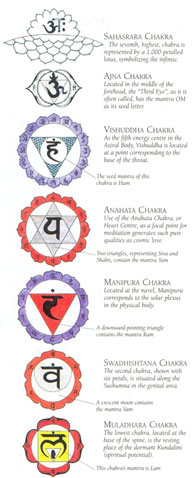
- The two aksharas , ‘a’ ( A ) and ‘h’ ( h ) are the first and the last letters of the alphabet respectively. The latter is the last of the Sibilants or the Shakti symbols. It is the aspirate and is uttered from the glottis or kaṇṭḥa ‘with an extra force of breath’. In terms of speech, its positioning in the glottis is adjacent to that of ‘a’ ( A ). Interestingly while the ‘a’ (A) sound is present in all the consonants, as discussed earlier, the ‘h’ ( h ) sound is present in half of the alphabet (barring the nasal stops). For example to the ‘ka’ ( k ) sound the aspirate is added to bring about the next letter ‘kha’ (K ). The former is called the alp-prana or ‘lesser life breath’ and the latter is called maha-prana or ‘larger life breath’.
The shlöka II.3.6 of Aitareya Ārāṇyaka explains this :-
……. ‘a’ is the whole of speech and being manifested through the mutes and the sibilants it becomes manifold and various. If uttered in a whisper, it is this ‘prāṇa’, if forcefully, that body – ‘sharira’. Therefore it is hidden, as hidden as the previous body encapsulated in this prāṇa . But spoken forcefully it is that body and visible, for body is visible. Now ‘a’ ( A ) is the immutable, the symbolic Unknown – if this is the whisper, then as we force the breath just a little, what we get is the aspirate sound ‘ah’ ( A: ) . It is both ‘a’ and ‘h’ combined. This is called the visarga sound. As shown in the akshara-wheel , at the top, the visarga is not included in the main alphabet and hence it is termed ayogavāḥ or ‘that which is not part of the harness’.
Now ‘a’ ( A ) is the immutable, the symbolic Unknown – if this is the whisper, then as we force the breath just a little, what we get is the aspirate sound ‘ah’ ( A: ) . It is both ‘a’ and ‘h’ combined. This is called the visarga sound. As shown in the akshara-wheel , at the top, the visarga is not included in the main alphabet and hence it is termed ayogavāḥ or ‘that which is not part of the harness’. 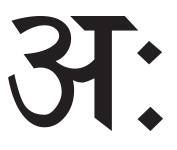 The visarga is the bija-mantra for the Sahasarāra or the Crown-chakra. Here we see that another level of the symmetry emerges – ‘ah’ ( A: ) closes the circle pictorially – signifying the internal/external division of the body or ātma. The individual ‘I’ has thus taken form and this is called ‘aham’ ( AhM ). It is the ‘ah’ ( A: ) sound with the Shiva bindu on top of it. Thus there is an inside and there is an outside – with the language of consciousness as the dividing membrane!
The visarga is the bija-mantra for the Sahasarāra or the Crown-chakra. Here we see that another level of the symmetry emerges – ‘ah’ ( A: ) closes the circle pictorially – signifying the internal/external division of the body or ātma. The individual ‘I’ has thus taken form and this is called ‘aham’ ( AhM ). It is the ‘ah’ ( A: ) sound with the Shiva bindu on top of it. Thus there is an inside and there is an outside – with the language of consciousness as the dividing membrane!
- Paṇinī, the oldest Indian grammarian who wrote his famous Asthadhyāyi few centuries before Christ, has explained a system of pratyahāra or abbreviation in which the first and the last letter actually include the entire list between them. In this light ‘ah’ ( A: ) can be understood as the pratyahara for the entire alphabet .
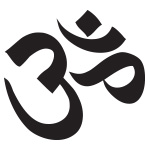 From the sound of ‘a’ ( A ) , the first letter to the sound of ‘m’ ( ma ) , the last letter of the mute-consonants the entire organ of speech is traced. The pronunciation travels from the glottis i.e. the guttural, along the palate to the cerebral region, from there to the dental and finally ends at the lips or the labial region. Thus, the entire mouth cavity is structured within this part of the alphabet and from here the symmetry gets reflected into the entire discursive language. Now, the mantra ‘aum’ ( ! ) can be understood as the pratyahāra for all these vowels plus all the mute-consonant sounds and hence the complete definition of the vocal apparatus starting from the glottis to the lips. This is the Universal mantra for the liberation of the senses and during meditation helps in suppressing the complete cacophony of thoughts and hence silencing the mind. This is the bīja-mantra for the Ājna-chakra located at the center of the forehead where the ceremonious tīkā is put during Indian rituals.
From the sound of ‘a’ ( A ) , the first letter to the sound of ‘m’ ( ma ) , the last letter of the mute-consonants the entire organ of speech is traced. The pronunciation travels from the glottis i.e. the guttural, along the palate to the cerebral region, from there to the dental and finally ends at the lips or the labial region. Thus, the entire mouth cavity is structured within this part of the alphabet and from here the symmetry gets reflected into the entire discursive language. Now, the mantra ‘aum’ ( ! ) can be understood as the pratyahāra for all these vowels plus all the mute-consonant sounds and hence the complete definition of the vocal apparatus starting from the glottis to the lips. This is the Universal mantra for the liberation of the senses and during meditation helps in suppressing the complete cacophony of thoughts and hence silencing the mind. This is the bīja-mantra for the Ājna-chakra located at the center of the forehead where the ceremonious tīkā is put during Indian rituals.
- The very first of the mutes or sparśa is ‘ka’ ( k ) and it is also the vedic aphorism for Prajāpati a reflection of Brahman. Śatpath Brāhmaṇa simply asks – “Who is the Unknown ?” and since kaḥ ( k: ) in Sanskrit means ‘who ?’ this then is the obvious ‘name’ for that which cannot be named.
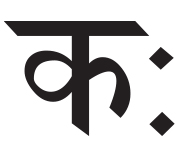
- As per Paṇinī ‘s system of pratyāhāra the word kam ( kma\ ) would stand for the entire list of mute consonants i.e from the first guttural ‘ka’ ( k ) to the last labial ‘ma’ ( ma ). Now, we look at the Brihadāraṇyaka Upanishad I.2.1which is the first shlöka of the ‘Hymn of Creation’ [7] as follows:-
….There was nothing whatsoever here in the beginning. It was the absence of time or mrtyuh, death that hid everything. For aśnāyā or that which has not emanated, in other words is un-manifested is equivalent to death. This aśnāyā- mrtyuh or the Unnameable, Brahman had a first thought in His mind, ‘Let me be’. This generated the first movement of thought and from this worship āpo emanated.…..’Verily’, he thought, ‘since my first desire has given rise to kam (within me)’, therefore this is the essence of energy or arka of all creation – he who understands kam thus comprehends the meaning (and control) of arka….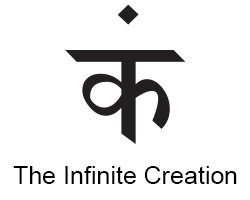 I.2.1 Both āpo and kam are hurriedly translated as ‘water’ in English versions of this shlöka. They are actually both ‘first’ emanations. Due to the desire to be, the infinite One expresses duality, right here the bifurcation of the internal mind and the external manifestation happens. āpo thus is the outward pervading matter, the plasma that is synonymous with arka or the very essence of Shakti ; kam is the expansion of thought within, turning into the seeds of the language, like Bhartṛhari’s sphöṭa. It germinates the links of words and sentences, helping to precipitate the very first desire into action.
I.2.1 Both āpo and kam are hurriedly translated as ‘water’ in English versions of this shlöka. They are actually both ‘first’ emanations. Due to the desire to be, the infinite One expresses duality, right here the bifurcation of the internal mind and the external manifestation happens. āpo thus is the outward pervading matter, the plasma that is synonymous with arka or the very essence of Shakti ; kam is the expansion of thought within, turning into the seeds of the language, like Bhartṛhari’s sphöṭa. It germinates the links of words and sentences, helping to precipitate the very first desire into action.
- Now Chāndogya Upaniśad IV.10.5 establishes the duality of Brahman, the Unknown’s desire to be by saying that…..

Here Agnī Deva, the Lord of Energy is explaining the secret of Brahman manifesting as different forms of fire or energies in the Universe. He says just as kam ( kma\ ) is the Infinite so is kham ( Kma\ ). As I have explained above that īśwara, is the manifest or pratyakśa form of the Unknown that lies within the realm of our senses. Synonymously kam ( kma\ ) too is like Aleph 1, א1 – the continuous infinity of Cantor’s theory of Infinities[8]. It too is uncountable and from it can emerge another infinite number of roots, words, sentences and so on that can name every possible form of creation. Then in the manifest speech of the sparśa the kham ( Kma\ ) is the reciprocal of the Aleph 1, א1 . This transformation gives the same diversity to kham ( Kma\ ) as is available in kam ( kma\ ) and also explains the fact that kham ( Kma\ ) means zero or shūnya in all ancient Vedic mathematical references. It is also used synonymously with ākāsha meaning vacuum or space.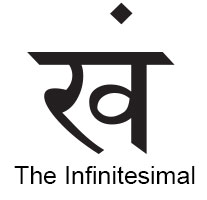 There are four aksharas, shown in green in the akshara-wheel viz. ‘ya’ ( ya ), ‘ra’ ( r ), ‘la’ ( la ) & ‘va’ ( va ). These are dual combinations of vowels and are called the semi-vowels or antaḥstha. These antaḥstha are so called because they are in-between the vowels and the mute consonants. However, the prefix antar means both ‘intermediate’ as well as ‘internal’. Thus they reflect the inner or ‘returning’ energies of the body or sharira. These four aksharas are the bija-mantra of the lowest four of the seven chakras according to the Shiva-sutras.
There are four aksharas, shown in green in the akshara-wheel viz. ‘ya’ ( ya ), ‘ra’ ( r ), ‘la’ ( la ) & ‘va’ ( va ). These are dual combinations of vowels and are called the semi-vowels or antaḥstha. These antaḥstha are so called because they are in-between the vowels and the mute consonants. However, the prefix antar means both ‘intermediate’ as well as ‘internal’. Thus they reflect the inner or ‘returning’ energies of the body or sharira. These four aksharas are the bija-mantra of the lowest four of the seven chakras according to the Shiva-sutras.
‘a’ ( A ) combines phonetically with the second pure vowel ‘i’ ( [ ) to give ( [+A) ; ‘ya’ ( ya ) and this is the bija-mantra for the Heart or the Anahata chakra. This signifies the reflection of the Ishvara and the Unknown in the hridaya or the human heart.
Similarly ‘a’ (A ) combines phonetically with the fourth pure vowel ‘ri’ ( ? ) to give ( ?+A) ; ‘ra’ ( r ) and this is the bija-mantra for the Navel or Manipur chakra. Ritah is the word for ‘order’ and it is through the navel that the umbilical cord introduces prana into the human body.
In the same manner‘a’ (A ) combines phonetically with the third & fifth pure vowels ‘u’ ( ] ) & ‘lri’ ( ; ) respectively to give ( ]+ A) ;‘va’ ( va ) and ( ;+ A) ; ‘la’ ( la ) these are the bija-mantras for the lowest two charkas – ‘va’ for the Genitals and ‘la’ for the Faecal position. These are called the Swadishthan & Muladhar chakras respectively.
These four aksharas are also called the yam ( yama\ ) symbols. And this is the name of Lord of Death in the Vedas thus it signifies time-bound decaying of energies. Interestingly, if we look at the akshara-wheel ( ma ) and ( ya ) are contiguous. If we go clockwise ‘yam’ ( yama\ ) could be the pratyahāra for the entire alphabet signifying its closure or death. On the other hand, if we go anti-clockwise from ( ma ) to ( ya ) and add an extra mātrā or meter to each syllable for extension in time – we get the unfolding of ‘māyā’ ( maayaa ) !
Now, we come back to the idea of shuddha-vikalpa and whether the concept of the Unnameable Highest Reality be brought within the realm of the matrika-shaktīs ?
The ‘entity’ that is the shuddha-vikalpa in the citta or consciousness itself is constituted of a ‘string of sounds’ or the ‘name’ or the shlöka that is the ‘description’ of the entity. Anything in the region of māyā ( maayaa ) or sounds belongs to the “countable” dimension of Shri Lakshmi. This is the space and time measure of everyday life where everything is definitive. But as we all know the next higher dimension belongs to “continuity” or Ushha and to achieve this the shuddha-vikalpa has to be repeated ‘innumerable’ times till it penetrates the Sādhak or practioner’s sub-conscious levels. Nothing else matters but this singular ‘string of sounds’ or the individual’s mantra. This repetitive chanting transcends the “probabilistic” nature of Reality and makes things happen! Much like the Quantum Mechanical theory of matter where no single event can be predicted but the probability of the experimental outcome is assured for a large number of identical experiments.
Once the Sādhak achieves this level of the Shāktopāya, he touches the next level of the Shāmbhavopāya where his very intent or icchā begins to manifest. And this is the realm of the Saraswati which has a runaway ecstatical effect on the Sādhak’s being and here the shuddha-vikalpa dissolves, negating itself and merging with Infinite (or the Infinitesimal Zero).
Let us look at this in another practical way…… The ‘intent to act’ is called the samkalpa and is first felt in the mind as a thought, as an idea to do something. This latent desire is in the realm of anahat-naad literally ‘unheard-sound’ and is also called the para-vaak or the region ‘beyond speech’. It is constructed out of our previous experience, the learned language, the symbolic memory and so on. The desire precipitates a need, a reason or a sense of purpose – this is what is called vikalpa . The mind observes, it searches for ways and means to crystallize this thought. This is the second layer of speech and it is called pashyanti. The next & third stage is madhyama, literally meaning ‘in-between’, where the life-force or prana lowers itself into the heart through 22 nervous paths called nadis. These 22 paths constitute the collection of shrutis and the heart is also the seat of the fourth chakra called the Anaahat-chakra for this reason. The breath or vayu rises from the navel or nabhi, the seat of the Manipura-chakra, in a ‘tight knot’[9] and combines with the prana in the hridaya or heart. Till now the sound is unbroken. As the vayu emerges from the throat, the Vishuddhi-chakra it finds distinction, delineation into the various components of speech and this fourth stage is called vaikhari. Till here the Shiva- sutras follow a 5th century A.D. scholar, Bhartrihari’s sphota theory of language. The sutras however add the matrika as the fifth stage of speech synthesis.
■■ Involution is the path of looking within ourselves. It is the path of meditation and yoga. And, a very important role, in this entire process, is played by the mantras – the ‘string of sounds’ well-knitted to enhance this inward journey. We went through four stages of evolution of speech in reaching matrika – the exposition of words and language. To summarize, these were, para-vaak, pashyanti, madhayma and vaikhari. Similarly there are four mantras to assimilate the returning energies of the Sādhak or practitioner. The first mantra, according to the Shiva- sutras, is ‘hamsa’. This mantra brings about the awareness of breathing. For, ‘ha’ is samhara-bija or the mystic letter denoting inspiration of breath and ‘sa’ is the shrishti-bija or the mystic letter denoting expiration. These sounds just happen as we inhale and exhale almost 21,600 times daily and the concentration on this fact enhances deep-breathing or prāṇayāma. Incidentally, the word ‘hamsa’ is also the name of the mythical white, swan-like bird which is very rarely seen and in folk-lore the flying away of this bird is likened to the release of prana at the time of death. These are the white swans on Goddess Saraswati’s sides.
The first mantra, according to the Shiva- sutras, is ‘hamsa’. This mantra brings about the awareness of breathing. For, ‘ha’ is samhara-bija or the mystic letter denoting inspiration of breath and ‘sa’ is the shrishti-bija or the mystic letter denoting expiration. These sounds just happen as we inhale and exhale almost 21,600 times daily and the concentration on this fact enhances deep-breathing or prāṇayāma. Incidentally, the word ‘hamsa’ is also the name of the mythical white, swan-like bird which is very rarely seen and in folk-lore the flying away of this bird is likened to the release of prana at the time of death. These are the white swans on Goddess Saraswati’s sides.
The second mantra is ‘soham’. Here the sequence of awareness is reversed – the ‘sa’ syllable for exhaling comes before the ‘ha’ syllable for inhaling. This mantra, therefore, starts the Sādhak on his inward journey and at the same time makes him aware of his deeper self. For, ‘aham’ means self and this mantra should be understood as ‘sa-aham’ being chanted rapidly.
The third mantra envelopes the second and adds the sound of the presiding deity Lord Shiva. Thus it is ‘Shivoham-shivoham’ and it is chanted in unison with the ‘in’ and ‘out’ breathing. The Sādhak rises above the multiplicity of the external reality and begins to merge with the dichotomy of the self and Shiva. Note that the sound of ‘aum’ is already ensconced in this and the previous mantra.
For, ‘aum’ is the last mantra. It is the bīja sound for the ‘third-eye’ or the Ājna-chakra. We have seen it is the abbreviation of the entire Sanskrit vowels and mute consonants from ‘a’ to ‘ma’ . Its annunciation traces the entire organ of speech from the glottis to the lips or the labial region. When chanted it resonates sonorously in the cranial cavity urging the Sādhak back towards the realm of para-vaak or the Unknown Naad-Brahman.
This then is the explanation of the matrika-shakti in the Shāktopāya.



